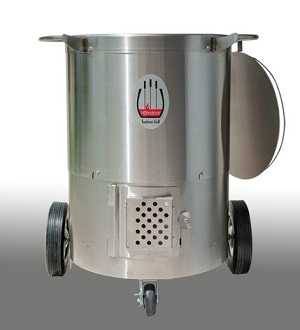YOU ARE HERE >> AmazingRibs » Ratings & Reviews » Hōmdoor Charcoal Tandoor Review
Hōmdoor Charcoal Tandoor Review
All of our reviews are done independently by our team of testers and are in no way influenced by advertising or other monetary compensation from manufacturers. Click here to learn more about our unbiased product review process.
Published On: 2/4/2013 Last Modified: 6/14/2025

The Homdoor Charcoal Tandoor is a traditional Indian clay oven which cooks meats and veggies on skewers, placed vertically into an open, upright cylindrical oven, and roasted at very high temperatures for a fairly short time. It has no cooking grate. Design, craftsmanship, and tradition have all come together in this tough, beautiful cooker.
Hōmdoor Charcoal Tandoor Design
The Homdoor has three layers: The stainless steel outer shell, a thick, cement-like, natural clay insulating layer, and the inner clay cooking surface. It so happens that this part of middle-west Ohio has a kind of clay which, in terms of porosity and strength and resistance to thermal shock, is perfect for high-temperature tandoor cooking. The thick insulating layer has more than one purpose. Retaining heat like crazy – when the inside temperature was near 500°F, the stainless steel shell was only 84° – the insulating layer also protects your investment from cracking.
Inner Chamber
The inner chamber is not strictly cylindrical, having an outward bulge (“belly”) at the middle that traps heat and moisture. The interior is not porcelain-coated or glazed, as that would prevent Indian naan or roti breads from sticking to the chamber walls where it bakes. Bonded to the insulating layer, the liner will continue to hold together and cook despite the inevitable crack.
Charcoal Grate
In the bottom of the cooking chamber is a cast iron charcoal grate. The ash chamber in the bottom is serviced through a well-designed combination door and slide damper that helps control airflow. Starting the charcoal is a breeze. Just two or three pounds of charcoal atop the charcoal grate, and place crumpled paper in the ash chamber below it. Light the paper underneath, lid off and damper wide open, and the charcoal directly above it will catch. A good old trick is to spray the paper with a little vegetable oil first. This gets the heat up where it catches the charcoal easily. An aluminum lid with a thin, stay-cool handle tops it off and is also used to control airflow.
Using the Hōmdoor Charcoal Tandoor
The Homdoor is almost ready for cooking right out of the box. Though the steps are simple, you will need two people to put it together because the parts are heavy. Overall, it’s 32″ high and 26.5″ wide (counting the handles), with a 28″ diameter base. The cooking chamber itself is 13.75″ in diameter (16″ in the belly) and 16″ deep. The learning curve for cooking meats is short. Put meat on the skewers, saving an onion or potato chunk for last to keep the meat from sliding off the skewer into the fire, lower the skewers into the fire, and you can get tender, juicy, seared meat in four to eight minutes. Vegetables are especially good; for example, sweet pepper. Skewered like a kebab, the pepper comes out hot, seared, and yet still crisp and full of flavor.
The learning curve for making naan or roti bread is steeper. You will find it challenging to get the dough consistency and the technique down, but you get to eat your mistakes. The dough is pushed onto a cloth pad called a Gaddi Pad, and then slapped against the interior wall of the hot Tandoor. As one’s skills develope, the tandoor can also be used to make shawarma, gyros, or even a version of Korean-style barbecued ribs. And it’s easy to clean, needing only a soap less scrubbing with a stiff-bristled (not wire) brush.
Extra Features
Included with the Homdoor are several skewers, which hang on a rod encircling the upper outside of the chamber, as well as a Gaddi Pad and a pair of bread tools. Additionally, improvements and new options for the Homdoor are in the plans. The owners discussed the possibility of an optional lid with hooks and a dial damper for hanging racks of ribs or BBQ brisket and cooking low-and-slow, so that design looks likely to be in the works soon. They also mentioned designing a pizza stone.
Homdoors are rugged, beautiful and appear to be designed to last. However, outside of manufacturing defects or shipping damage, there is no warranty.
Click the buttons below to search our complete database of reviews:
Product Information:
-
Model:Charcoal Tandoor
-
Item Price :1,550.00
*Price Subject To Change -
Review Method:Cooked On It
We have hands-on experience testing this product. We have also gathered info from the manufacturer, owners and other reliable sources. -
Primary Function:Grill, Egg or Kamado Style, Drop Ins
-
Fuel:Charcoal
-
Primary Capacity:Small (about 7 burgers) : 144 square inches
Manufacturer:
-
Hōmdoor: Tandoori Grill for the Home
Here’s some delicious irony: Instead of reporting on yet another grill being made overseas, here we have an Indian tandoor being made in the heartland of America. Deep in the hills of Ohio, the Superior Clay Corporation manufactures the Homdoor Tandoor, a new object of desire for the outdoor cook. The only tandoor manufacturing company that we know of in the US, it started when the owner, Ron Levy, a renowned ceramicist, was challenged by a New York City restaurant owner to make a commercial tandoor. He and his wife and business partner, Beth Kaminstein, approached Superior Clay. A bounty of collaboration, work, and design produced the Homdoor, a free-standing tandoor oven perfect for your deck, your patio, or your backyard.
Most sales are direct from Homdoor.
-
Max Good, AmazingRibs.com’s Full-Time Grill Tester - Max Good is AmazingRibs.com's Vice President of Product Reviews & Keeper of the Flame and is the world's only full-time reviewer of outdoor cooking equipment including smokers, grills, pizza ovens, griddles, and more.


High quality websites are expensive to run. If you help us, we’ll pay you back bigtime with an ad-free experience and a lot of freebies!
Millions come to AmazingRibs.com every month for high quality tested recipes, tips on technique, science, mythbusting, product reviews, and inspiration. But it is expensive to run a website with more than 2,000 pages and we don’t have a big corporate partner to subsidize us.
Our most important source of sustenance is people who join our Pitmaster Club. But please don’t think of it as a donation. Members get MANY great benefits. We block all third-party ads, we give members free ebooks, magazines, interviews, webinars, more recipes, a monthly sweepstakes with prizes worth up to $2,000, discounts on products, and best of all a community of like-minded cooks free of flame wars. Click below to see all the benefits, take a free 30 day trial, and help keep this site alive.
Post comments and questions below
1) Please try the search box at the top of every page before you ask for help.
2) Try to post your question to the appropriate page.
3) Tell us everything we need to know to help such as the type of cooker and thermometer. Dial thermometers are often off by as much as 50°F so if you are not using a good digital thermometer we probably can’t help you with time and temp questions. Please read this article about thermometers.
4) If you are a member of the Pitmaster Club, your comments login is probably different.
5) Posts with links in them may not appear immediately.
Moderators